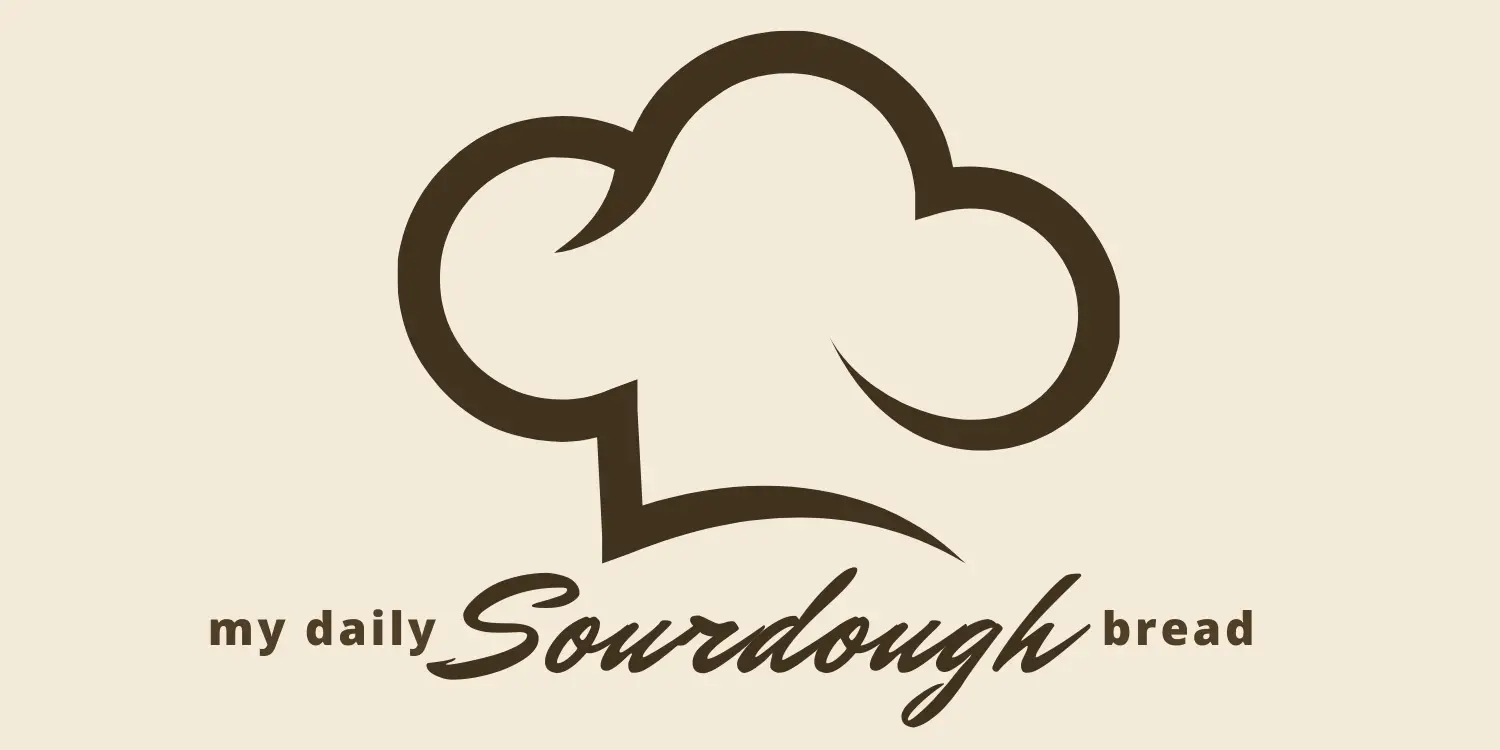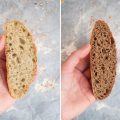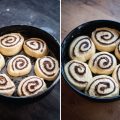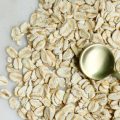Baking whole wheat sourdough bread is both a nourishing and gratifying endeavor. Unlock the secrets to perfecting this wholesome, flavor-rich bread, transforming your baking experience and enriching your culinary options!
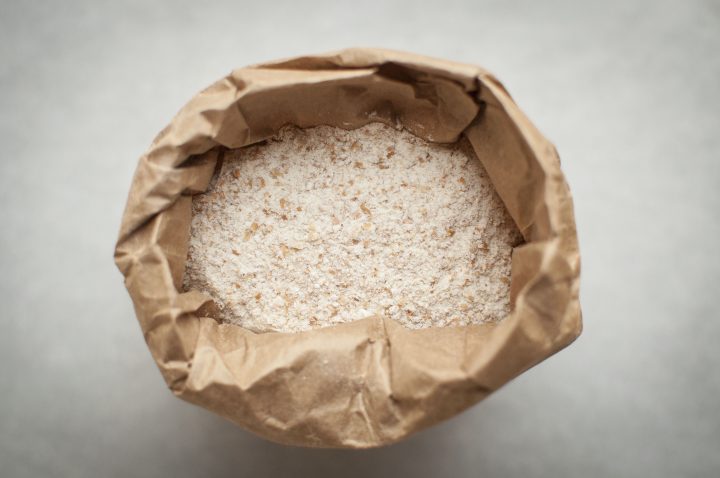
Table of Contents
- What is Whole Wheat Sourdough Bread?
- What to Know Before Making Whole Wheat Sourdough Bread
- Whole Wheat Sourdough Bread Recipe
- Tips for Whole Wheat Sourdough Bread Recipe
- Troubleshooting and Solutions
- How to Store Whole Wheat Sourdough Bread
- What to Serve with Whole Wheat Sourdough
- Whole Wheat Wonders: Crafting the Perfect Loaf
- FAQs
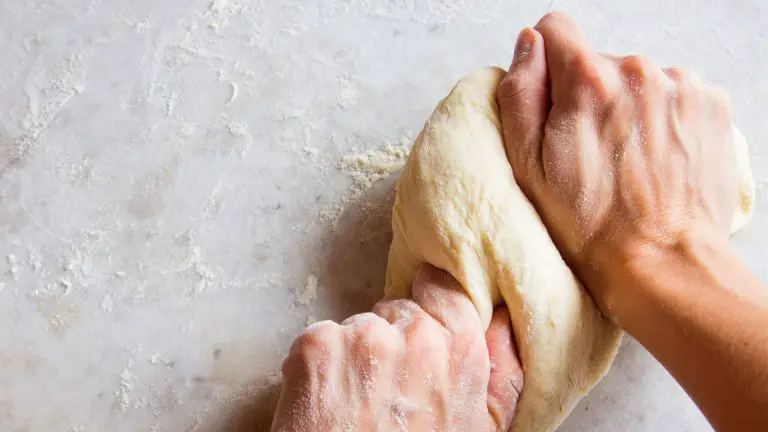
Whole Wheat Sourdough Bread Recipe
- Total Time: 13 hrs 20 mins
- Yield: 1 loaf 1x
Ingredients
- 200 g whole grain wheat flour + 200 g water for sourdough starter
- 130 g whole grain wheat flour
- 170 white wheat flour
- 120 g water
- 10 g fine sea salt
- 10 ice cubes for creating steam during baking
Instructions
- In the evening, mix 200 g of whole grain wheat flour with 200 g of water and 1 heaping tablespoon of (active) rye sourdough starter. Cover and let it ferment overnight until bubbly and doubled in volume.
- In the morning, your starter should be active and risen.
- Next, prepare the dough. In a large bowl mix together all of the above well risen starter (400 g), 120 g of water, and 300 g of flour. Mix until all ingredients come together. Cover the bowl with a cloth and let it sit for 10 minutes.
- In the meantime, prepare your rising basket. Make sure your basket is well floured so the dough will not stick to it when taking it out. I like to line my rising basket with a kitchen cloth.
- After 10 minutes, add 10 g of salt and knead the dough for 8 minutes until smooth.
- Shape the loaf. Stretch the dough a little bit and then fold the upper third of the dough over the middle. Turn the dough for 180° and repeat. Then, fold the upper half over the lower half and pinch well. You can see the shaping part in the video from the previous post. Transfer the dough to a rising basket and sprinkle some flour over the dough as well.
- To rise the loaf, you have several options: you can rise it just at the room temperature (it will probably take two hours, depending on the temperature of you kitchen), you can first rise it at the room temperature and then put it in a fridge or you can rise it in a fridge only. I left my loaf for two hours in a fridge and two more hours at the room temperature. Your dough is ready when it passes the poking test and the indent doesn’t spring back quickly.
- Since my Dutch oven is too small, I used my baking stone to bake this whole grain wheat loaf. At least 30 minutes before baking preheat your oven to the maximum temperature of your oven along with a baking stone and a baking pan, which you put under the baking stone on a lower rack.
- When ready, take the loaf out of the rising basket and transfer it to the baking stone. I use my pizza peel for this. Throw 10 ice cubes on a baking pan, close the door and lower the temperature to 235°C/455°F. Leave the loaf to bake for 35-40 minutes or until nicely brown. If necessary, turn the loaf for couple of times to brown it evenly.
- Cool on a cooling rack before cutting.
Notes
- You could also use unfed sourdough starter directly from the fridge, it will work as well.
- Prep Time: 12 hrs 40 mins
- Cook Time: 40 mins
- Category: bread
There is something special about the whole grain flour. About the bran in it. It seems the entire grain’s story sneaks to the light, if there is just a pair of ears to hear it. The story is about sunbathing, bending in the wind, resistance, and growth. About ups and downs. About the time needed to mature. Today I will tell you that story, while showing you how to make the perfect whole wheat sourdough bread.
What is Whole Wheat Sourdough Bread?
Whole wheat sourdough bread is made from whole wheat flour and a live sourdough culture. Whole wheat sourdough has a rich, nutty, slightly sour taste and aroma. The hearty slices are chewy with a rustic appearance that comes from the bran flecks visible throughout.
Sourdough vs Whole Wheat Sourdough
While regular sourdough and whole wheat sourdough share the same rising method, they differ in ingredients, texture, taste and nutrition.
- Taste: The most noticeable distinction lies in flavor. Traditional sourdough has a prevalent sour tang and slight sweetness. Whole wheat sourdough still carries that signature sourdough zing but has rich, nutty notes from the whole wheat. The bran and germ provide a more complex, earthy quality. Which tastes better comes down to personal opinion.
- Health Benefits: When it comes to nutrition, whole wheat sourdough wins due to more fiber, protein, vitamins and minerals. Whole wheat loaves also tend to have a lower glycemic index, keeping blood sugar stable.
- Trickier to Work With: Dealing with whole wheat flour can prove more challenging since it’s more absorbent. Bran also cuts through gluten strands, resulting in denser loaves that don’t rise as high. Gentler handling is key. Allow for longer fermentation times to develop flavor and structure. While not as pillowy, the chewy crumb and nutty essence make whole wheat sourdough well worth the effort.
What to Know Before Making Whole Wheat Sourdough Bread
Ultimately, with the right mindset and materials, nothing should hold you back from baking picture-perfect whole wheat sourdough. These are things to take note of so you can be prepared.
Choosing the Best Whole Wheat Flour
Not all whole wheat flours bake the same, so use one specifically formulated for bread.
Hard whole wheat flours with 12-14% protein content yield the most satisfyingly chewy sourdough. They derive from hard wheat varieties that give stronger gluten development. Steer clear of coarse “wheat grind” flours suited for muffins over loaves. All-purpose flour lacks nutrients, so only use judiciously for adjustment.
Getting the Hydration Right
Hydration refers to the water content of the dough, measured by weight as a percentage of the flour. Whole wheat flours need more hydration – often 80% or higher. Enough moisture allows the bran to soften so loaves rise properly and form that nice holey structure. But too much water makes dough sticky and unwieldy. Start with 80% hydration and adjust from there.
Must-Have Baking Tools
A kitchen scale that measures in grams helps with precision. Invest in a stand mixer or heavy-duty hand mixer to vigorously knead dense doughs. Use an instant-read thermometer to monitor water temperature and test for doneness. Proofing baskets give loaves a professional look. And Dutch ovens create the perfect steamy environment for oven spring.
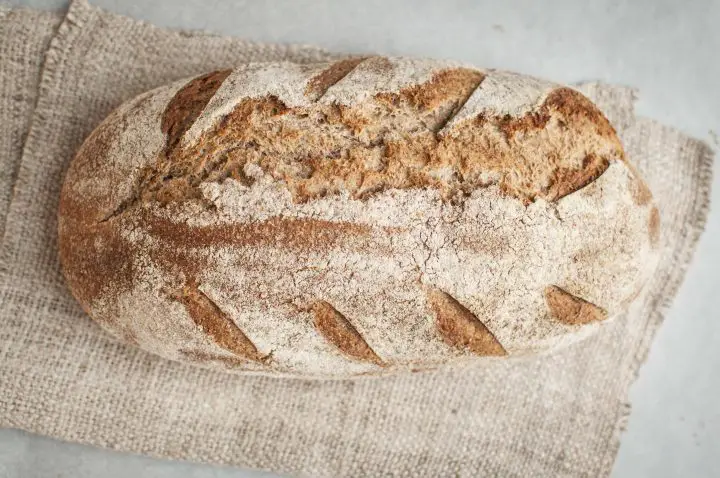
Whole Wheat Sourdough Bread Recipe
Ingredients for the Whole Wheat Sourdough Bread
Yields: this whole wheat sourdough recipe makes 1 big loaf
- 200 g whole grain wheat flour + 200 g water for sourdough starter
- 130 g whole grain wheat flour
- 170 white wheat flour
- 120 g water
- 10 g fine sea salt
- 10 ice cubes for creating steam during baking
How to Make the Perfect Whole Wheat Sourdough
- In the evening, mix 200 g of whole grain wheat flour with 200 g of water and 1 heaping tablespoon of (active*) rye sourdough starter. Cover and let it ferment overnight until bubbly and doubled in volume. (*you could also use unfed sourdough starter directly from the fridge, it will work as well.)
- In the morning, your starter should be active and risen.
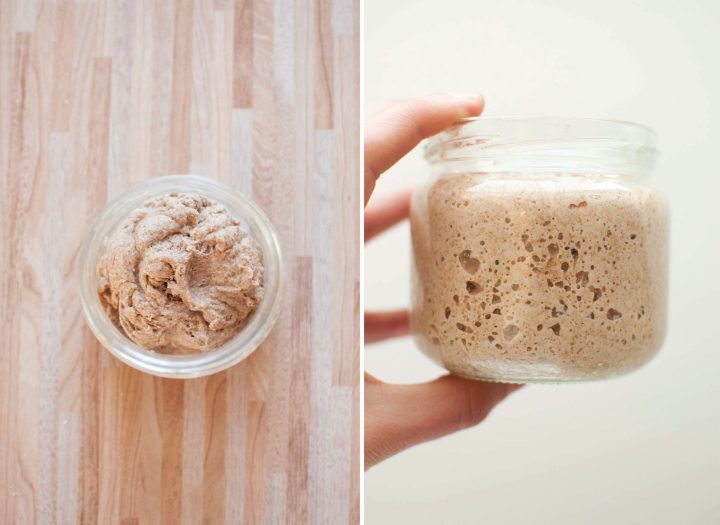
- Next, prepare the dough. In a large bowl mix together all of the above well risen starter (400 g), 120 g of water, and 300 g of flour. Mix until all ingredients come together. Cover the bowl with a cloth and let it sit for 10 minutes.
- In the meantime, prepare your rising basket. Make sure your basket is well floured so the dough will not stick to it when taking it out. I like to line my rising basket with a kitchen cloth.
- After 10 minutes, add 10 g of salt and knead the dough for 8 minutes until smooth.
- Shape the loaf. Stretch the dough a little bit and then fold the upper third of the dough over the middle. Turn the dough for 180° and repeat. Then, fold the upper half over the lower half and pinch well. You can see the shaping part in the video from the previous post. Transfer the dough to a rising basket and sprinkle some flour over the dough as well. (check out my video below to demonstrate)
- To rise the loaf, you have several options: you can rise it just at the room temperature (it will probably take 2 hours of dough rest, depending on the temperature of you kitchen), you can first rise it at the room temperature and then put it in a fridge or you can rise it in a fridge only. I left my loaf for two hours in a fridge and two more hours at the room temperature. Your bread dough is ready when it passes the poking test and the indent doesn’t spring back quickly.
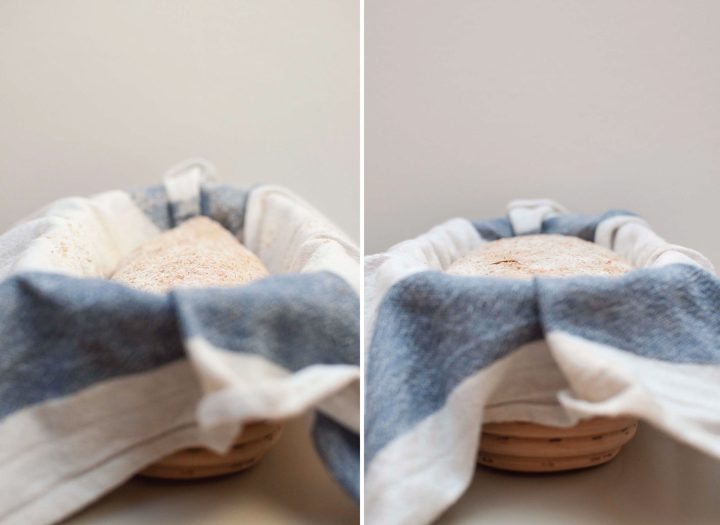
- Since my Dutch oven is too small, I used my baking stone to bake this whole grain wheat loaf. At least 30 minutes before baking preheat your oven to the maximum temperature of your oven along with a baking stone and a baking pan, which you put under the baking stone on a lower rack.
- When ready, take the loaf out of the rising basket and transfer it to the baking stone. I use my pizza peel for this. Throw 10 ice cubes on a baking pan, close the door and lower the temperature to 235°C/455°F. Leave the wheat loaf to bake for 35-40 minutes or until nicely brown. If necessary, turn the loaf for couple of times to brown it evenly.
- Cool on a cooling rack before cutting.
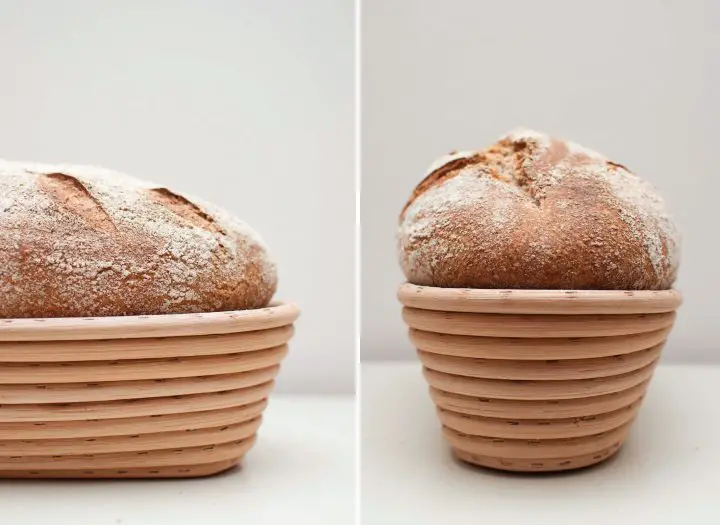

Tips for Whole Wheat Sourdough Bread Recipe
I like to bake whole grain wheat loaf during the week, when I spent most of the day at work and in the afternoons you can find me everywhere else but in the kitchen. But I bake my bread anyway, I can’t help myself.
I prepare larger quantities of starter in the morning, knead the dough when I come back from work and let it rise in the fridge or at the room temperature, depending on how hungry I am.
In both cases, it rises quite fast because there is much more sourdough starter in the bread than usually.
In this recipe wrote the instructions for how to prepare the bread if you start in the evening.
Troubleshooting and Solutions
With a bit of experimentation and adjusting, your whole wheat sourdough is sure to be flawless. Troubleshooting is all part of the journey to artisan loaf mastery!
Dense or Heavy Bread
If your sourdough turns out as dense bricks rather than airy loaves, lack of gluten development is likely the culprit. Whole wheat flour has less gluten than white flour.
Next time, try adding vital wheat gluten and kneading vigorously for at least 10 minutes to reinforce the structure. Allowing for a longer bulk fermentation time also helps the dough become more extensible.
Poor Rise or No Oven Spring
Sometimes whole wheat doughs struggle to double in size or get that last rise in the oven. This happens when yeast activity is low.
Using an active starter and proofing in a warm area speeds fermentation. If your kitchen is cold, put the covered dough near a heating vent or appliance for better rise. Failing that, just bake smaller boules.
Burnt Bottom Crust
Overly browned or burnt bottom crusts result from too much direct heat.
When baking in a Dutch oven, ensure it’s well preheated before loading dough for more even heating. If using a baking stone, add a layer of parchment paper between it and the loaf. Also lower the temperature 25°F once bread is loaded to prevent scorching.
How to Store Whole Wheat Sourdough Bread
Use a serrated bread knife to neatly slice the loaf without tearing the tender interior. Cut thicker slices for heartier sandwiches or thinner for toast and appetizers. Wrap individual slices in parchment paper to grab and go for packed lunches or on-the-run breakfasts. Freezing pre-cut slices makes it easy to take out just what you need.
Store in Breathable Containers
Keep cut sourdough in a paper bag or bread box rather than wrapping in plastic or foil which causes sogginess. The paper allows moisture to escape while keeping the crust crisp. An airtight plastic container works for unmanned loaves, just avoid overpacking slices so air can still circulate. Store on the countertop for 2-3 days and freeze for longer duration.
What to Serve with Whole Wheat Sourdough
Beyond just enjoying whole wheat sourdough plain, its nutty, tangy flavor profile pairs wonderfully with sweet and savory foods. Let creative cravings and ingredient inspiration guide you on tasty culinary adventures.
Breakfast Possibilities
For breakfast, whole wheat toast shines when topped with smashed avocado, poached eggs, and chili flakes for a satisfying savory start. Another winning combo is peanut or almond butter with banana slices and cinnamon.
For something sweeter, use thick slices as bases for lemon curd, ricotta and berry compotes. Toasted with butter and drizzled honey also makes mornings magical.
Lunchtime Creations
Build hearty sandwiches on whole wheat sourdough with fillings like hummus, veggies and sprouts or chicken salad loaded with celery, pecans and mayo.
Sourdough grilled cheeses ooze beautifully when the bread gets nicely toasty. Tomato soup is also a classic pairing – just dunk crusty corner chunks directly into the steaming bowl.
Dinner Companions
Pre-dinner bread baskets filled with whole wheat sourdough, butter and garlic confit get appetites ready for hearty mains like pot roast, beef stew or mushroom risotto. Use thick slices to wipe up the last savory sauces on the plate.
Chunky vegetable soups and garden salads also benefit from whole wheat croutons for bite and texture contrast. These recipes on my blog for yummy soups will definitely make this wheat sourdough bread extra good:
Other Sourdough Flavors
You can try incorporating other flavors into this recipe, such as:
- Roasted Pumpkin Seed Pesto Sourdough Bread using Pumpkin Seed Pesto
- Wild Garlic Sourdough Using Khorasan Wheat and 100% Whole Grain Wheat
- Best Sweet Corn Sourdough
Whole Wheat Wonders: Crafting the Perfect Loaf
Baking sourdough is so rewarding. With dedication to the process, a discerning palate and some trial and error, you will be rewarded with loaves bursting with nutrient-dense nourishment and irresistible taste.
This whole wheat bread loaf is very delicious, it has nutty flavor and has really soft crumb. The aroma of home-baked whole wheat sourdough wafting from your kitchen is simple yet profound joy.
Smile knowing that with each bite of this bread, you created something wonderful using your own hands. Keep embracing the pleasures of home baking – your friends and family will relish the fruits of your labor too!
I obviously love sourdough baking. Here are more sourdough bread recipes featuring grains:
- Sourdough Rye Bread Recipe with Homemade Yogurt
- 100% Whole Grain Einkorn Sourdough Bread Recipe
- Spelt Sourdough Bread
Let me know me how this wheat bread worked for you 🙂
FAQs
Is whole wheat sourdough bread healthy?
Yes, whole wheat sourdough bread is generally considered healthy. However, as with any food, moderation and individual dietary needs should be considered.
Is whole wheat good for sourdough?
Whole wheat flour is a great option for making sourdough bread, providing both nutritional benefits and delicious flavor. Whole wheat flour is made from the entire wheat kernel, including the bran and germ, which contain fiber, vitamins, and minerals. This makes whole wheat flour a more nutritious option than refined white flour. Whole wheat flour can also provide a nutty, slightly sweet flavor to sourdough bread, and it can help create a denser, more rustic texture.
How does whole wheat flour affect sourdough?
Using whole wheat flour in sourdough bread can provide both nutritional benefits and unique flavor and texture. It’s important to keep in mind that using whole wheat flour can require some adjustments to the recipe and process, and it may result in a slightly different final product than bread made with white flour.
Is whole wheat sourdough healthier than white sourdough?
Whole wheat sourdough is a healthier option than white sourdough due to its higher nutrient content, lower glycemic index, and other health benefits. However, it’s important to note that both types of sourdough can be part of a healthy diet when consumed in moderation.
